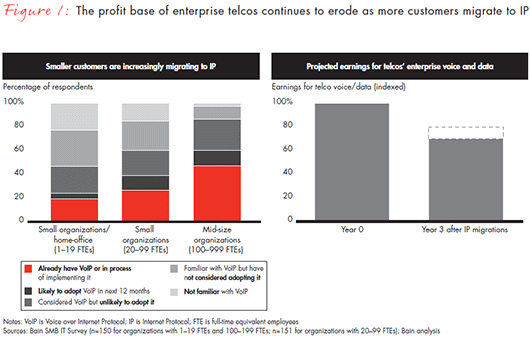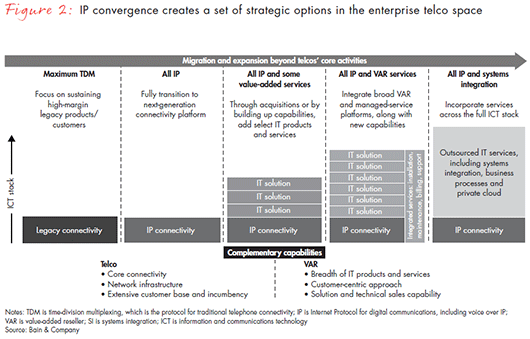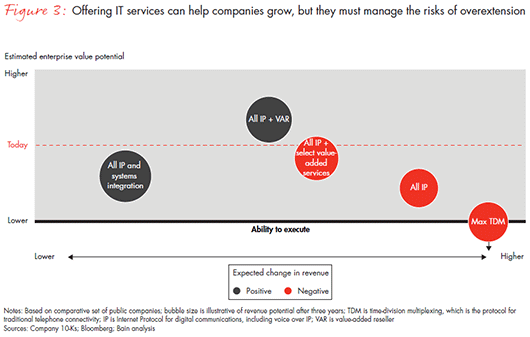Brief
 }
}
The enterprise business of telecommunications faces a crisis of eroding top and bottom lines as customers switch over from traditional, margin-rich time-division multiplexing (TDM) to financially less attractive Internet Protocol (IP) connectivity. IP connectivity allows enterprises to realize greater flexibility, cost savings and new services, but it has contributed to eroding revenues and profits for telcos—in some cases by 20% to 30% over a three-year span (see Figure 1). The entry of a wide range of competitive players delivering enterprise services over IP not only complicates the position of traditional telcos, but poses the threat of displacing them.

This disruption creates a dilemma for traditional telcos, which must balance short-term incentives to cling to the high margins of their traditional systems against the long-term benefits of investing in IP infrastructure and services, which are clearly the future (see Figure 2).
Continuing to offer traditional TDM may yield healthy cash flows in the near term, but with the decline and obsolescence of this technology, markets would penalize the valuations of providers that have not transitioned to IP connectivity. Merely switching to IP, with few or no related services, would offer a sustainable business model, but because of lower price points, it would come at the cost of reduced revenue, leading to a lower valuation and unsatisfactory outcomes for shareholders.
A more sustainable option is migrating to IP connectivity while making IT services available. The IT services market is expected to grow 6% annually over the next several years, spurred by the rise of “as a service” and other new models, which are seeing annual growth rates above 20%. Expanding services, however, has risks at both ends of the spectrum. A limited expansion may not be enough to sufficiently grow the business, while overextending services to include IT system integration could be more than most telcos are able to provide, given that it’s a fundamentally different type of business.

Teaming with VARs
For some telcos, acquiring and leveraging the capabilities and assets of a value-added reseller (VAR) might be the most potent and optimal strategy—yet it is often undervalued and few adopt it (see Figure 3). Acquiring a suitable VAR may enable a telecom provider to materially augment its top line without overextending into a full suite of integrated IT services, since the VAR delivers proven assets and capabilities to succeed in the services market.

In our work with telcos, we have found that they can share up to 75% of their top customers with VARs, making it simpler to create a one-stop shop for information and communications for small, medium and even large enterprise customers.
But success depends on getting senior executives comfortable with the notion of acquiring a VAR to bring new business capabilities in-house. Telecom industry veterans are typically more comfortable investing in real assets, such as spectrum and network infrastructure, than in talent—which can simply walk out the door.
Successful integrations follow a proven playbook that creates synergistic value for the combined business while addressing the major strategic risks, including how to retain and integrate the best talent from both organizations.
Herbert Blum, a partner in the Telecommunications practice, explains how value-added resellers (VARs) may help telecom companies overcome structural challenges.
Since telcos and VARs are different businesses, the key to a successful partnership lies in allowing both to flourish under the same roof and in reinforcing each other’s individual strengths, which is a delicate but attainable balance to strike. We have identified a three-step playbook for success:
- Determine whether VAR integration is the right strategic choice. While the potential is great, the process of acquiring and integrating a VAR can be expensive and complex, and not every telco needs to go through it to thrive in an IP world. Those with the scale and resources to build their own services organizations could focus on developing capabilities organically as they transition to IP connectivity. Smaller providers will likely need the boost that a VAR acquisition can deliver.
- Identify and acquire the right VAR. The appropriate acquisition will have more than a healthy balance sheet and income statement. To make the most of the telco’s existing network and to increase the likelihood of a shared customer base, the target company should have significant geographic overlap with the telco. The VAR should also have complementary offerings that add value to the telco’s current services, as well as strong relationships with technology partners. Ideally, the VAR should have a similar go-to-market model, including delivery and billing platforms that can be integrated with the acquirer’s platforms. And most important, the ideal acquisition should have excellent customer loyalty, as demonstrated by a high Net Promoter ScoreSM (a measure of customer advocacy), relative to peers.
- Integrate with a great sense of measure and balance. This last step requires the most skill from senior executives, as telcos and VARs generally have very different cultures. Telcos are highly structured and take an engineered approach to business, whereas VARs typically are more flexible and take an opportunistic approach to fulfilling customers’ needs. Personal tensions among senior executives can complicate integration, especially if some leaders are averse to the integration. Hence, integrating a VAR is a delicate effort that requires significant attention from executives, for example, to strike the right balance between what and what not to integrate. The ideal operating model is like a race car with two engines under its hood.
A short set of principles can help leaders realize success:
- Complete alignment of the senior leadership. Senior executives should define and agree on goals, direction and strategy. They should also agree on issues involving people and power. Harmony at the top goes a long way to creating confidence and commitment throughout the rest of the organization.
- Secure harmony across both organizations. Be willing to accept some additional complexity in managing the company, if necessary, to preserve distinct cultures, capabilities and talent. In fact, celebrate differences where appropriate and encourage cross-fertilization where it makes sense—keeping in mind common goals and strategy.
- Prioritize investments in the right solutions. A joint telco-VAR product committee should make decisions based on market opportunities for the combined business, above existing relationships and opportunities. Recognize that some decisions will need a telco-grade business case and some ideas will require VAR-like experimentation and very quick responses to new opportunities with clients. To remain agile and keep costs and complexity down, develop solution bundles—which reduce the burden of having to structure packages—by sourcing capabilities from third parties, whenever possible.
- Cross-sell effectively. Adopt a bias toward more generous rewards for leads, even if it means paying commissions to both the referrer and the seller. Focus sales conversations on clients’ needs, bringing in expertise from the telco or the VAR.
- Principles over process. Aim to manage to these principles rather than adhering to a stringent integration process, remembering that accomplishing the organization’s shared goals remains the top priority, even if that means improvising at times. Finally, openly share the successes of the combined organization to reinforce momentum across the shared entity.
Herbert Blum is a partner with Bain & Company in Toronto. Jamie Cleghorn is a partner in Chicago. Christophe Van de Weyer is a partner in Brussels, and Prashanth Aluru is a partner in New Delhi. All four work with the firm’s Global Telecommunications practice.
Net PromoterSM is a registered trademark of Bain & Company, Inc., Fred Reichheld and Satmetrix Systems, Inc.
Net Promoter ScoreSM and Net Promoter SystemSM are trademarks of Bain & Company, Inc., Fred Reichheld and Satmetrix Systems, Inc.